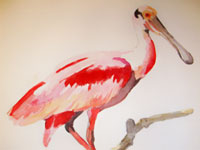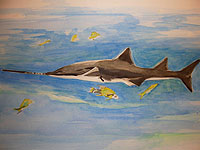Bald Eagle
 The majestic bald eagle, our national bird, is a bird of prey found throughout North America. Florida has the the second-largest population of bald eagles in the United States. Bald eagles live year-round in Florida near the coastline, rivers and other large bodies of water and primarily feed on fish. They are most often seen perching in mature stands of coniferous and hardwood trees or soaring through the sky with slow, strong beats of their wings.
The majestic bald eagle, our national bird, is a bird of prey found throughout North America. Florida has the the second-largest population of bald eagles in the United States. Bald eagles live year-round in Florida near the coastline, rivers and other large bodies of water and primarily feed on fish. They are most often seen perching in mature stands of coniferous and hardwood trees or soaring through the sky with slow, strong beats of their wings.
Bald eagles usually mate with one another for life and are very sensitive to human activity. Adults are brown, with white heads and tails. Juveniles have brown heads. Most adults weigh between 9 to 13 pounds and have a wingspan of between 5.5 to 8 feet. Successful efforts to protect this bird have led to it being moved from the “Endangered” to the “Threatened” species list. Their primary threats are illegal hunting and loss of habitat.

Manatee
 Manatees are large, grey water mammals that average ten feet in length and weigh between 440 to 1300 pounds. They are vegetarians, and eat up to 10 – 15% of their body weight in grass and other vegetation each day. They live in fresh, brackish, and salt water. In Duval County, manatees travel north and south in the Intercoastal Waterway close to the shoreline, and feed in small tributaries. While manatees inhabit Duval County year-round, the highest concentrations are found here during the summer, as many migrate towards the warmer waters of southern Florida by late fall.
Manatees are large, grey water mammals that average ten feet in length and weigh between 440 to 1300 pounds. They are vegetarians, and eat up to 10 – 15% of their body weight in grass and other vegetation each day. They live in fresh, brackish, and salt water. In Duval County, manatees travel north and south in the Intercoastal Waterway close to the shoreline, and feed in small tributaries. While manatees inhabit Duval County year-round, the highest concentrations are found here during the summer, as many migrate towards the warmer waters of southern Florida by late fall.
These gentle, social creatures travel in groups, and are one of the only wild animals known to frequently approach humans. The presence of manatees is indicated by a series of smooth, flat circles on the surface of the water. They also can be spotted when they poke their noses out of the water to breathe. Manatees are endangered, with only about 2,000 left in Florida, and are facing extinction. One of their greatest threats is being struck by boats, and most manatees have multiple scars from boat propellers scoring their bodies. Conservation groups discourage human interaction with manatees, as it may lead to manatees approaching boats. To help protect these peaceful creatures, drive boats slowly and carefully in manatee zones and help keep their habitat clean.

Right Whale
 Adult female North Atlantic right whales and their calves can be seen off the North Florida shoreline from December through March. During these winter months, adult females migrate down the North Atlantic eastern coastline from Canada to northern Florida to calve. They usually swim close to the shoreline and are black in color. Adults are 36 to 59 feet long and weigh between fifty-four to seventy-three tons (108,000 to 146,000 pounds). Although they move slowly, they are highly acrobatic, frequently leaping in the air and slapping their tails on the water. With only about 400 in existence, they are one of the rarest marine mammals and are critically endangered.
Adult female North Atlantic right whales and their calves can be seen off the North Florida shoreline from December through March. During these winter months, adult females migrate down the North Atlantic eastern coastline from Canada to northern Florida to calve. They usually swim close to the shoreline and are black in color. Adults are 36 to 59 feet long and weigh between fifty-four to seventy-three tons (108,000 to 146,000 pounds). Although they move slowly, they are highly acrobatic, frequently leaping in the air and slapping their tails on the water. With only about 400 in existence, they are one of the rarest marine mammals and are critically endangered.

Roseate Spoonbill
 Roseate Spoonbills live in groups in the marshes and rivers of northern Florida year-round and nest in mangroves. They are visually-striking birds, with white heads that turn green during breeding season; white necks, backs and breasts; and light and dark pink wings. They have long legs and a wing span of about four and a half feet. Their elongated, spoon-shaped bills allow them to sift small crustaceans and bugs out of brackish, fresh, and ocean water. Pigments in the crustaceans give roseate spoonbills their unusual pink coloring.
Roseate Spoonbills live in groups in the marshes and rivers of northern Florida year-round and nest in mangroves. They are visually-striking birds, with white heads that turn green during breeding season; white necks, backs and breasts; and light and dark pink wings. They have long legs and a wing span of about four and a half feet. Their elongated, spoon-shaped bills allow them to sift small crustaceans and bugs out of brackish, fresh, and ocean water. Pigments in the crustaceans give roseate spoonbills their unusual pink coloring.
In the 1800s, hunters seeking these birds’ flamboyant feathers for ladies’ hats and fans caused the population to dwindle down to only a few dozen breeding pairs in the United States. Fortunately, efforts to protect this species were successful and the population has recovered to the extent they are no longer a protected species.

Smalltooth Sawfish
 Smalltooth Sawfish are nocturnal marine animals of the ray family. While their habitat used to extend from the western Atlantic Ocean from Long Island down to Brazil, this endangered species now lives predominantly off the coast of Florida. They are most often found in the shallow, muddy waters of bays and estuaries. Their menacing appearance features a long, saw-like, rectangular nose, or nostrum, rounded at the tip, punctuated with 23 to 34 teeth on each side.
Smalltooth Sawfish are nocturnal marine animals of the ray family. While their habitat used to extend from the western Atlantic Ocean from Long Island down to Brazil, this endangered species now lives predominantly off the coast of Florida. They are most often found in the shallow, muddy waters of bays and estuaries. Their menacing appearance features a long, saw-like, rectangular nose, or nostrum, rounded at the tip, punctuated with 23 to 34 teeth on each side.
They use their nostrum for defense, and also to slash through schools of fish, stunning and injuring the fish before eating them. Very little is known about smalltooth sawfish in Florida, but it is believed adults are between 10 feet and 20 feet in length and weigh around 700 pounds. They only attack humans when provoked or surprised.

Special thanks go to Barbara Holmes-Fryefield for creating and donating these stunning illustrations. All “Waterway Critters” illustrations are owned and copyrighted by Barbara Holmes-Fryefield and may not be used without her express permission.



